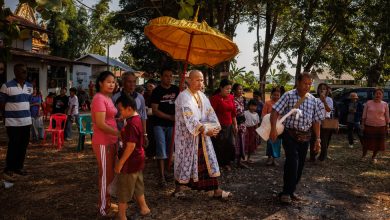Nan Melville, Whose Photography Captured Dance in Many Forms, Dies at 72

Nan Melville, a photographer who was known for elegant, fluid images of prominent dancers and dance companies, died on March 18 in Manhattan. She was 72.
Her sister, Gill Kenyon, announced the death. The cause was not specified.
Ms. Melville’s dance photography, which appeared in numerous publications, including The New York Times, as well as in various books on dance, spanned four decades. She photographed the Bolshoi Ballet, the Alvin Ailey American Dance Theater, the Ballet Nacional de Cuba, the Royal Ballet of Britain, American Ballet Theater and numerous other well-known troupes, capturing dancers like Mikhail Baryshnikov and the Alvin Ailey star Dwana Smallwood in gravity-defying leaps or amid swirling costumes. But she was just as much at home photographing traditional Venda dancers in South Africa or experimental works at avant-garde spaces like the Kitchen in Manhattan.
Later in her career, she added videography to her skill set. She even made a short documentary, “Nrityagram: For the Love of Dance” (2010), about a dance school and ensemble in India.
“Much of the dance footage, not least during the closing credits, is spellbinding,” Alastair Macaulay, chief dance critic of The New York Times, wrote of the documentary when it played at the Dance on Camera Festival in New York in 2010. “I wanted the film to be twice as long.”
Ms. Melville may have been destined to be a dance photographer. Her father, William Melville, was a diamond valuator in South Africa but dabbled in photography and making home movies as hobbies. Her mother, Enid Hilda (Jobson) Melville, was a ballet dancer and teacher. (“I believe she was doing pliés just before I was born,” Ms. Melville wrote about her mother in an autobiographical sketch on her website.)
“Since childhood,” Ms. Melville said, “images, the movement of light, colors, impressions — both still and moving — have been most important to me.”
The interplay of motion and color in the performing arts, especially dance, appealed to her.
“Photography,” she said simply, “is drawing with light.”
Septime Webre, artistic director of the Hong Kong Ballet, worked with Ms. Melville when he was artistic director of the American Repertory Ballet in New Jersey in the 1990s.
“Nan captured images through her heart more than through her eyes,” he said, adding that she “knew how to capture movement in ways that distilled the intention of the dancer, but, more importantly, her images abounded with her love affair with dance.”
Nanette Rose Melville was born on Oct. 7, 1949, in Kimberley, in South Africa’s Northern Cape province. She became interested in photography as a teenager and pursued the hobby while studying drama and English at Rhodes University in Makhanda, South Africa.
“The photographs I took of the plays we performed were very well received and planted a seed of an idea,” she wrote on her website. “Maybe my hobby could possibly one day transition into a livelihood.”
After earning a bachelor’s degree, she taught high school English, drama and speech in South Africa from 1973 to 1980. Then, in 1981, she got to turn that hobby into a vocation: She landed a job as a photographer for the Performing Arts Council of the Transvaal, a regional arts organization.
After five years in that position, she made an exploratory trip to New York and ended up settling there, building a freelance photography career centered on dance. She photographed performances major and minor there, but, as she noted on her website, “Nothing makes me happier than dusting off my passport.”
Assignments over the years took her to back to South Africa as well as to Asia and Europe and, repeatedly beginning in 1990, to Cuba. At her death, she was working on a documentary about dance in that country, with an emphasis on the Ballet Nacional de Cuba.
Ms. Melville’s sister is her only immediate survivor.
An assignment for The Times in 1996 to photograph an appearance in New York by the Nrityagram Dance Ensemble of India led to the documentary that was one of Ms. Melville’s most ambitious projects. She met Protima Gauri Bedi, founder of the troupe and its associated school, which sought to preserve elements of Indian classical dance.
“Protima and I became friends within hours,” Ms. Melville recalled in a 2011 interview with the weekly newspaper India Abroad. “She came to see me in my studio and said, ‘You must come to India and see our work.’”
The resulting collaboration led to Ms. Melville’s documentary, which won awards at several film festivals. Ms. Bedi, though, never saw the finished film; she died in a mudslide in a Himalayan mountain village in 1998.
Ms. Melville later said that as she worked on the film, “I had a feeling she was watching over me.”





